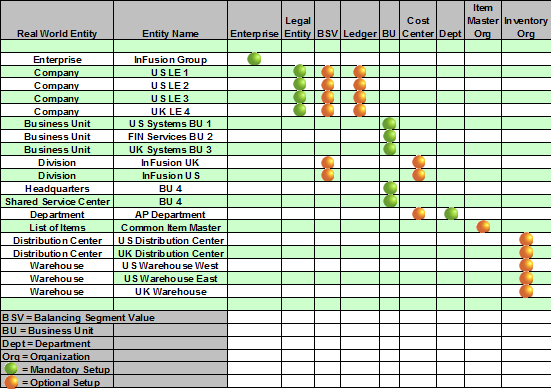Model Your Enterprise Management Structure
This example uses a fictitious global company to demonstrate the analysis that can occur during the enterprise structure configuration planning process.
Scenario
Your company, InFusion Corporation, is a multinational conglomerate that operates in the United States (US) and the United Kingdom (UK). InFusion has purchased an Oracle Fusion Cloud Enterprise Resource Planning (ERP) solution including Oracle General Ledger and all of the Oracle Fusion Cloud Applications subledgers. You are chairing a committee to discuss creation of a model for your global enterprise structure including both your US and UK operations.
InFusion Corporation
InFusion Corporation has 400 plus employees and revenue of 120 million US dollars. Your product line includes all the components to build and maintain air quality monitoring applications for homes and businesses. You have two distribution centers and three warehouses that share a common item master in the US and UK. Your financial services organization provides funding to your customers for the initial costs of these applications.
The following are elements you must consider in creating your model for your global enterprise structure.
-
Your company is required to report using US Generally Accepted Accounting Principles (GAAP) standards and UK Statements of Standard Accounting Practice and Financial Reporting Standards. How many ledgers do you want to achieve proper statutory reporting?
-
Your managers need reports that show profit and loss (revenue and expenses) for their lines of business. Do you use business units and balancing segments to represent your divisions and businesses? Do you secure data by two segments in your chart of accounts which represents each department and legal entity? Or do you use one segment that represents both to produce useful, but confidential management reports?
-
Your corporate management requires reports showing total organizational performance with drill-down capability to the supporting details. Do you need multiple balancing segment hierarchies to achieve proper rollup of balances for reporting requirements?
-
Your company has all administrative, account payables, procurement, and Human Resources functions performed at their corporate headquarters. Do you need one or more business units in which to perform all these functions? How is your shared service center configured?
Global Enterprise Structure Model
The following figure and table summarize the model that your committee has designed and uses numeric values to provide a sample representation of your structure. The model includes the following recommendations:
-
Creation of three separate ledgers representing your separate legal entities:
-
InFusion America Inc.
-
InFusion Financial Services Inc.
-
InFusion UK Services Ltd.
-
-
Consolidation of results for application components, installations, and maintenance product lines across the enterprise
-
All UK general and administrative costs processed at the UK headquarters
-
US Systems' general and administrative costs processed at US Corporate headquarters
-
US Financial Services maintains its own payables and receivables departments


In this chart, the green globe stands for required and gold globe stands for optional setup. The following statements expand on the data in the chart.
-
The enterprise is required because it serves as an umbrella for the entire implementation. All organizations are created within an enterprise.
-
Legal entities are also required. They can be optionally mapped to balancing segment values or represented by ledgers. Mapping balancing segment values to legal entities is required if you plan to use the intercompany functionality. The InFusion Corporation is a legal entity but isn't discussed in this example.
-
At least one ledger is required in an implementation in which you record your accounting transactions.
-
Business units are also required because financial transactions are processed in business units.
-
A shared service center is optional, but if used, must be a business unit.
-
Divisions are optional and can be represented with a hierarchy of cost centers or by a second balancing segment value.
-
Departments are required because they track your employees.
-
Optionally, add an item master organization and inventory organizations if you're tracking your inventory transactions in Oracle Fusion Applications.